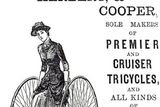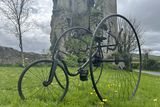Big wheels keep on turnin’ at old Irish bicycle auction
12 bicycles going under the hammer come with a wealth of history and heritage




The invention of the bicycle changed rural Ireland for ever. Towns that took a day to reach on foot were now a few short hours away.
People could make the journey and return on the same day. The bicycle gave many women their first taste of freedom, and young people could socialise like never before.
But until the 1950s, the price of a bicycle was out of reach of many.
The playwright John B. Keane (1928-2002) wrote in the Limerick Leader that when he was a teenager, a bicycle was often the only way of getting to and from dances: “While it was not always possible to borrow a bike, it was generally easy enough to get a lift on the bar.”
Looking back, he reflected, “there are few moments which can compete with barring a good-looking girl over an open road of a moonlight night”.
The 12 bicycles going under the hammer at Sheppard’s Great Irish Interiors auction on Friday, May 3, come from a single collection, a kind of history told in bikes.
Advertisement for tricycles
The earliest is interesting but incomplete, the remnants of a velocipede made of iron and wood around 1869 and sold by P. Ledwidge, 32 Amiens Street, Dublin (Lot 1702: est. €300 to €500).
This forerunner of the bicycle was invented by the Michaux family in Paris at a time when the shortage of oats — akin to a fuel crisis — created a need for horseless transport.
Constructed of iron and wood without springs, it was known as a “boneshaker” and propelled by pedalling cranks attached to the front axle.
Adult-sized tricycles, often propelled by a system of hand levers, were a safer alternative to the ‘ordinary bicycle’ and could be ridden by ladies in long skirts
Its successor, the ‘ordinary bicycle’, was a death trap with unevenly sized wheels that positioned the rider 1.5 metres from the ground.
The nickname ‘penny farthing’ comes from the comparative size of the wheels. The larger, on which the pedals were mounted, was compared to a penny; the smaller rear wheel to the little farthing coin.
Invented by Eugène Meyer of Paris in 1869, they were fast, exciting and dangerous. A rut in the road could send the rider flying.
Such accidents were called ‘taking a header’ or ‘coming a cropper’. They happened often and could be fatal.
The penny farthing in the sale (Lot 1739: est. €4,000 to 6,000) was made around 1880 with solid rubber and tangential-spoked wheels, turned wood handle bar ends, and a sprung seat with leather covering.
Adult-sized tricycles were a safer alternative to the ‘ordinary bicycle’ and could be ridden by ladies in long skirts.
A penny farthing
In 1876, the Irishman, William Bindon Blood, patented his Dublin tricycle, which became the first three-wheeler in commercial production. Between 1881 and 1886, more tricycles than bicycles were made in Great Britain (which then included Ireland).
They were marketed as an aristocratic ride and illustrations of Queen Victoria on her tricycle encouraged others to jump on the trend.
The tricycle in Sheppard’s sale (Lot 1689: est. €4,000 to €6,000) was made around 1884 and is attributed to Hillman, Herbert and Cooper, of Coventry.
The company’s patrons include the Earl of Portarlington whose seat was at Emo Court, Queen’s County (now Co Laois).
All earlier models were eclipsed by the ‘safety bicycle’ (so called to differentiate it from the highly unsafe penny farthing), invented by John Kemp Starley around 1885.
Even the early models look remarkably like today’s bicycles. The pneumatic tyre, which made cycling much more comfortable, was invented by John Dunlop (1840-1921) of Belfast.
A 19th century tricycle
Ireland took to bicycles like a duck to water. Both republican and crown forces were quick to spot their military potential.
When Éamon DeValera was arrested in 1918, he’d planned to introduce a bicycle riding cavalry.
The sale includes a First World War-era double-barred British Military Humber bicycle (lot 1769: est. €400 to €600), with the lower bar designed to mount a rifle.
A butcher’s bicycle (Lot 1844: est. €300 to €500) from the 1930s is a sturdy vehicle with a wicker basket that fits into a steel frame at the front, while a 1950s post office bicycle (Lot 1612: est. €300 to €500) has a flat carrier at the front that supported a postbag.
See sheppards.ie
Join the Irish Independent WhatsApp channel
Stay up to date with all the latest news





















